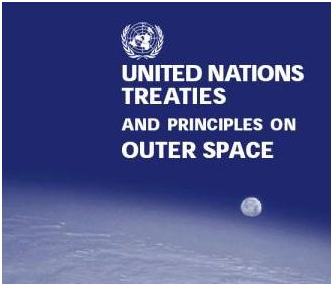Last week I blogged about The Treaty on Principles Governing the Activities of States in the Exploration and Use of Outer Space, the first important treaty on space law which was signed in 1967. In the same year another space treaty was signed called the Agreement on the Rescue of Astronauts, the Return of Astronauts and the Return of Objects Launched into Outer Space. As the name implies, this treaty had to do with the rescue of astronauts landing in a signatory nation as well as the return of launched space objects which have landed to the country of origin. This agreement was created by a consensus vote in the United Nations General Assembly. Critics have said that the wording of the treaty was vague and subject to different interpretations.
In 1972, the Convention on International Liability for Damage Caused by Space Objects expanded on the liability provisions included in the Outer Space Treaty. This treaty says that any object launched into space from the territory of a signatory nation is the responsibility of the nation from which it was launched. Therefore, any damages caused by such a space object must be compensated for by the launching nation.
The Convention on Registration of Launched Objects into Outer Space was adopted by the U.N. General Assembly in 1974 and went into force in 1974. This treaty provides for the registration of any and all objects launched into space from any signatory nation. This registration includes the name of the state that launches the object, a unique designator or registration number, the date and location of the launch, basic orbital parameters and the function of the launched object. In 2007, the U.N. General Assembly passed a resolution to add additional information to the register including, Coordinated Universal Time, kilometers, minutes and degrees as standard units, additional useful information about function, geostationary orbital position for such satellites, change of status such as ceasing function, approximate date of orbital decay or re-entry, date and conditions of moving a space object to an orbit that permits disposal and any web links to official information on a space object.
In 1979, the Agreement Governing the Activities of States on the Moon and Other Celestial Bodies was drafted to turn over jurisdiction of all celestial bodies and orbits around them to the international community. All activities in space would have to conform to the United National Charter and other international law. Basically, this treaty bans the military use of celestial bodies and orbits and requires that all space activities must be reported to an international body. All exploration and exploitation of space must be acceptable to the international community and benefit all signatories. The treaty would also ban any declaration of sovereignty by a government or declaration of ownership by a private party of any celestial body or orbit. No nation capable of launching objects into space has signed on to this treaty to date.
These five treaties constitute the major documents that cover legal matters with respect to the exploration and exploitation of space by signatory nations on Earth.
